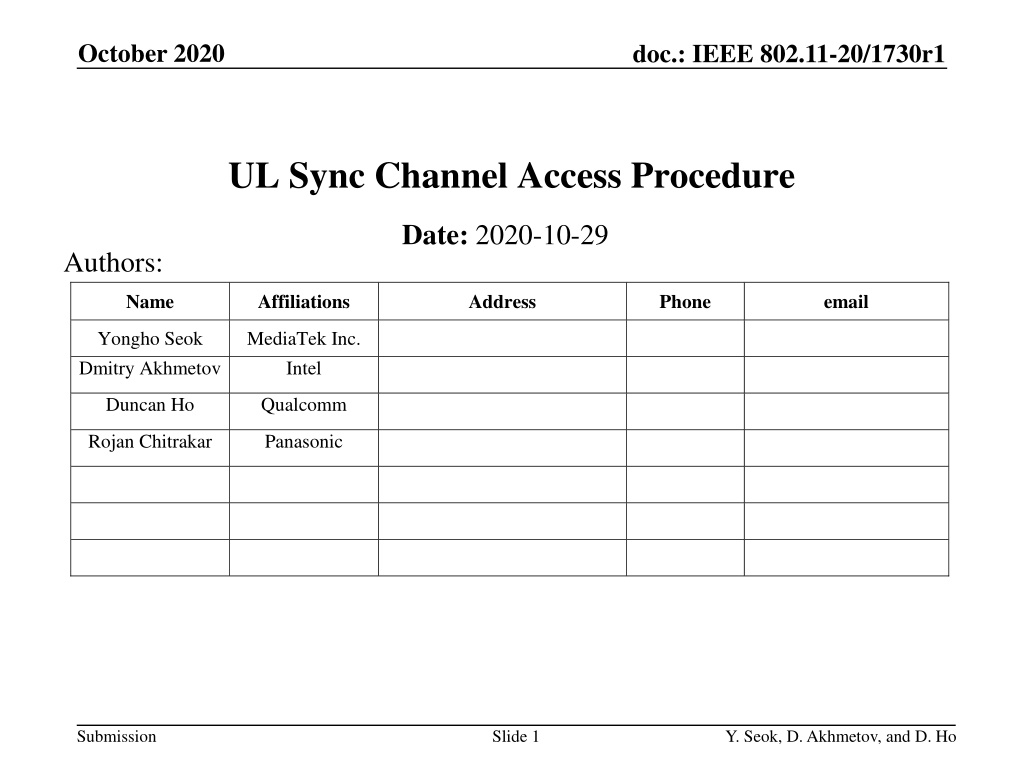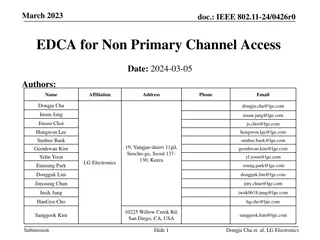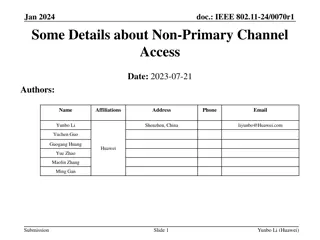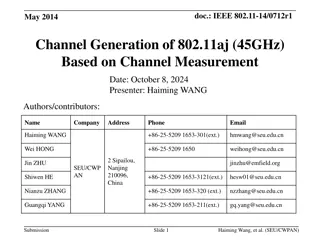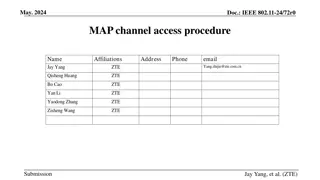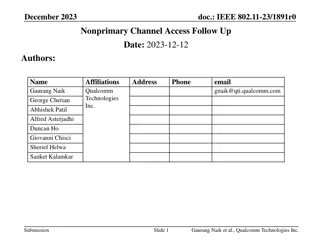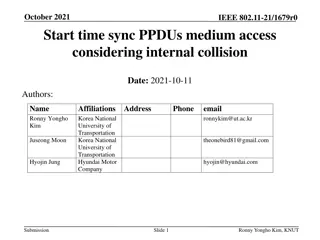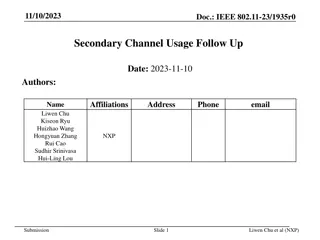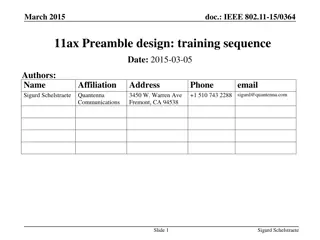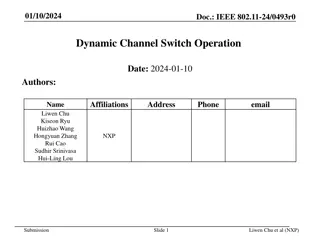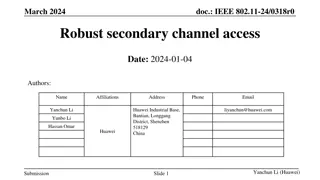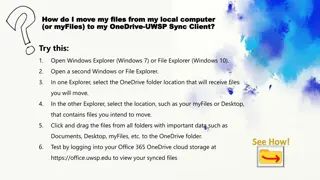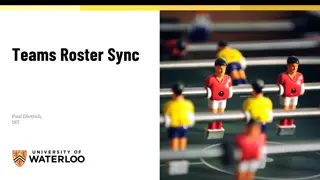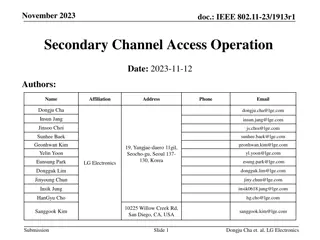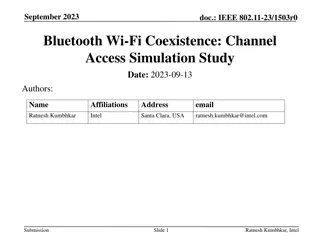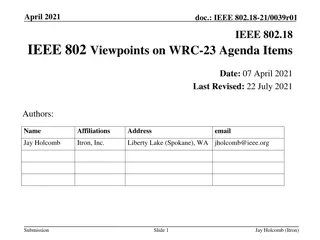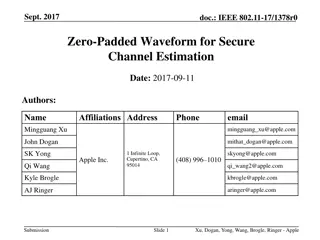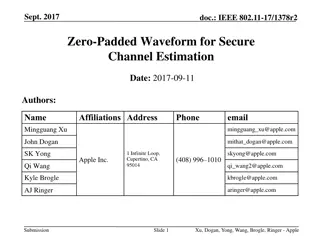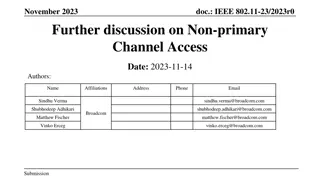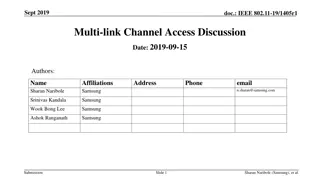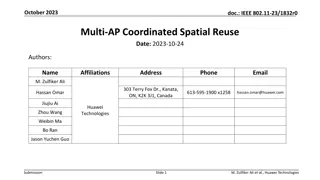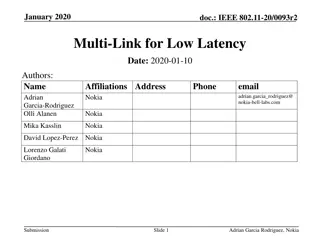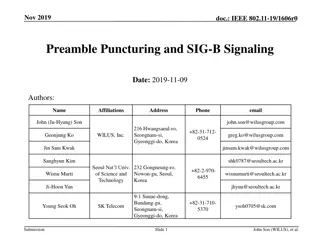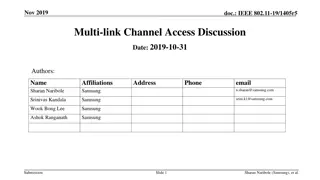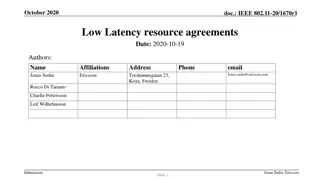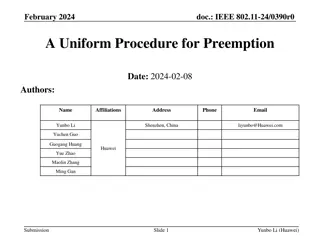UL Sync Channel Access Procedure in IEEE 802.11-20/1730r1
The document discusses the UL sync channel access procedure in IEEE 802.11, focusing on the conditions under which an STA affiliated with an MLD can initiate transmission, manage its backoff counter, and follow specific rules for accessing the channel. It proposes a straw poll to gather support for the outlined channel access procedure.
Download Presentation

Please find below an Image/Link to download the presentation.
The content on the website is provided AS IS for your information and personal use only. It may not be sold, licensed, or shared on other websites without obtaining consent from the author. Download presentation by click this link. If you encounter any issues during the download, it is possible that the publisher has removed the file from their server.
E N D
Presentation Transcript
October 2020 doc.: IEEE 802.11-20/1730r1 UL Sync Channel Access Procedure Date: 2020-10-29 Authors: Name Affiliations Address Phone email Yongho Seok Dmitry Akhmetov MediaTek Inc. Intel Duncan Ho Qualcomm Rojan Chitrakar Panasonic Submission Slide 1 Y. Seok, D. Akhmetov, and D. Ho
October 2020 doc.: IEEE 802.11-20/1730r1 Abstract Regarding the UL sync channel access procedure, 11-20/993 (D. Akhmetov et al.) and 11-20/1053 (Y. Seok et al.) have been presented in August and proposed a similar position. I.e., a STA whose backoff reaches zero may not transmit a PPDU and keep its backoff counter at zero until the backoff counter of other STA affiliated to the same MLD reaches zero. This contribution proposes a straw poll of a general UL sync channel access procedure as a follow-up of 11- 20/1053 and 11-20/993 that were already discussed before. Submission Slide 2 Y. Seok, D. Akhmetov, and D. Ho
October 2020 doc.: IEEE 802.11-20/1730r1 Straw Poll Do you support an STA that is affiliated with an MLD shall follow the channel access procedure described below? a) The STA may initiate transmission on a link when the medium is idle and one of the following conditions are met: 1) The backoff counter of the STA reaches zero on a slot boundary of that link. 2) The backoff counter of the STA is already zero, and the backoff counter of another STA of the affiliated MLD reaches zero on a slot boundary of the link that the other STA operates. b) When the backoff counter of the STA reaches zero, it may choose to not transmit and keep its backoff counter at zero. c) If the backoff counter of the STA has already reached zero, it may perform a new backoff procedure. CW[AC] and QSRC[AC] is left unchanged. Submission Slide 3 Y. Seok, D. Akhmetov, and D. Ho
October 2020 doc.: IEEE 802.11-20/1730r1 Backup Highlight of MLO synchronous channel access procedure learned from current backoff procedure: a) The STA may initiate transmission on a link when the medium is idle and one of the following conditions are met: 1) The backoff counter of the STA reaches zero on a slot boundary of that link. 2) The backoff counter of the STA is already zero, and the backoff counter of another STA of the affiliated MLD reaches zero on a slot boundary of the link that the other STA operates. b) When the backoff counter of the STA reaches zero, it may choose to not transmit and keep its backoff counter at zero. c) If the backoff counter of the STA has already reached zero, it may perform a new backoff procedure. CW[AC] and QSRC[AC] is left unchanged. Submission Slide 14 Y. Seok, D. Akhmetov, and D. Ho
October 2020 doc.: IEEE 802.11-20/1730r1 Backup Highlight of MLO synchronous channel access procedure learned from current backoff procedure: For example, When the backoff counter of the STA1 reaches zero, the STA1 does not transmit and keep its backoff counter at zero based on the rule b. The STA1 initiates a TXOP based on the rule a-2. The STA2 initiates a TXOP based on the rule a-1. Rule a-1 TX A-MPDU Rx BA 9 8 7 6 5 4 3 2 1 0 STA2 Rule b Rule a-2 4 3 2 1 0 Rx BA TX A-MPDU STA1 MLD Submission Slide 14 Y. Seok, D. Akhmetov, and D. Ho
October 2020 doc.: IEEE 802.11-20/1730r1 Backup Highlight of MLO synchronous channel access procedure learned from current backoff procedure: a) The STA may initiate transmission on a link when the medium is idle and one of the following conditions are met: 1) The backoff counter of the STA reaches zero on a slot boundary of that link. 2) The backoff counter of the STA is already zero, and the backoff counter of another STA of the affiliated MLD reaches zero on a slot boundary of the link that the other STA operates. b) When the backoff counter of the STA reaches zero, it may choose to not transmit and keep its backoff counter at zero. c) If the backoff counter of the STA has already reached zero, it may perform a new backoff procedure. CW[AC] and QSRC[AC] is left unchanged. Submission Slide 14 Y. Seok, D. Akhmetov, and D. Ho
October 2020 doc.: IEEE 802.11-20/1730r1 Backup Highlight of MLO synchronous channel access procedure learned from current backoff procedure: 6 5 4 3 2 Busy STA4 Empty Rule c 1 0 3 2 1 0 Rx BA TX A-MPDU STA3 MLD 8 7 6 5 4 Busy STA2 Empty AIFS Rule c 1 0 3 2 1 0 TX A-MPDU Busy STA1 MLD Submission Slide 14 Y. Seok, D. Akhmetov, and D. Ho
October 2020 doc.: IEEE 802.11-20/1730r1 References [1] https://mentor.ieee.org/802.11/dcn/20/11-20-0993-07-00be-sync-ml- operations-of-non-str-device.pptx (D. Akhmet and L. Cariou) [2] https://mentor.ieee.org/802.11/dcn/20/11-20-1053-01-00be- synchronous-multi-link-transmission-of-non-str-mld.pptx (Y. Seok and D. Ho) Submission Slide 8 Y. Seok, D. Akhmetov, and D. Ho
